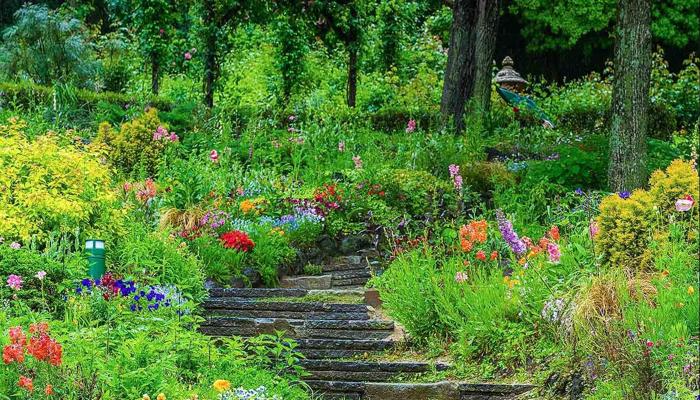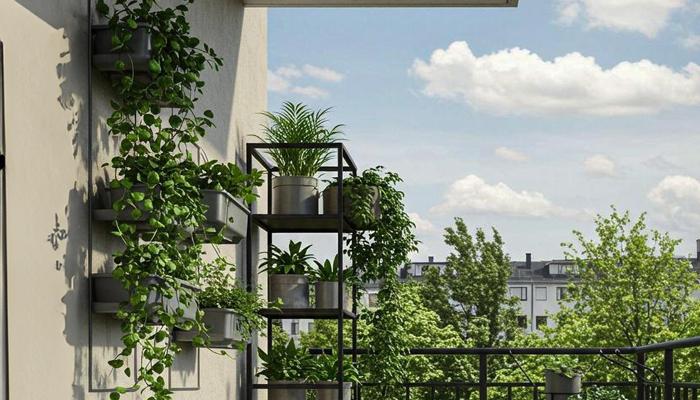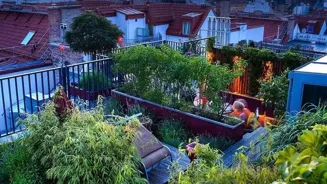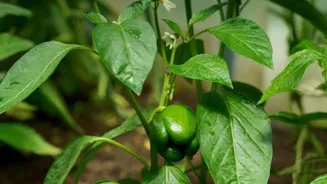Transform your terrace into a lush oasis! Discover 7 tips for a stunning urban garden in Mumbai, India. Read more!
Mumbai, India – Are you tired of the concrete jungle and yearning for a slice of greenery
in your city life? Well, fret not! Transforming your terrace into a vibrant urban garden is easier than you think.
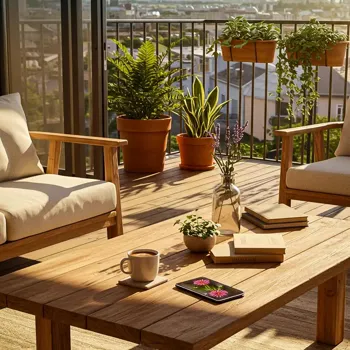
Imagine stepping out onto your terrace and being greeted by a riot of colours, fragrant herbs, and the gentle buzz of bees. Creating a thriving terrace garden not only adds beauty to your home but also offers a refreshing escape from the hustle and bustle of city life.
With a little planning and the right know-how, you can turn your terrace into a stunning oasis. So, grab your gardening gloves and let's dive into seven essential tips to create the urban terrace garden of your dreams!
Learn rooftop gardening secrets from experienced gardeners
From selection of plants to watering techniques, get ready to unearth secrets from experienced gardeners and transform your roof into a garden.
Understanding terrace conditions vital for successful gardening
First and foremost, understanding your terrace is paramount. Before diving headfirst into plant selection and potting mixes, take a good hard look at your terrace. Consider the amount of sunlight it receives throughout the day. Is it bathed in sunshine all day long, or does it get mostly shade?

This will directly influence the types of plants that will thrive in your space. Also, assess the weight-bearing capacity of your terrace. Soil, pots, and water can add significant weight, so it's crucial to ensure your terrace can handle the load.
If you're unsure, consult a structural engineer for advice. Once you have a clear picture of your terrace's conditions, you can start planning your garden layout. Think about how you want to use the space. Do you want a relaxing seating area surrounded by flowers?
Or a productive vegetable garden that provides fresh produce for your family? Map out your vision on paper to get a better idea of how to utilize the space effectively. Remember to factor in access to water.
Carrying water buckets up to the terrace can be tiresome, so if possible, consider installing a water tap or using a long hose. Lastly, consider privacy.
If your terrace is overlooked by neighbouring buildings, you can use tall plants or screens to create a sense of seclusion and enjoy your outdoor space in peace.
Choose plants wisely for a successful rooftop garden; consider climate, sunlight, and plant variety
Now, it is very important to choose the plants for your rooftop garden. Now, choosing the right plants is the heart of any successful terrace garden. Opt for plants that are well-suited to the climate and growing conditions of your area.
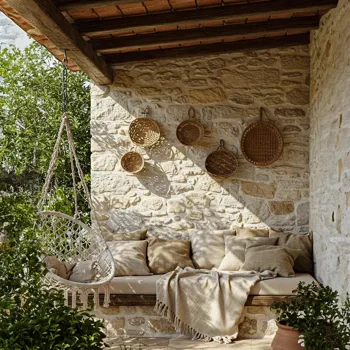
Native plants are always a good choice as they are naturally adapted to the local environment. For sunny terraces, consider drought-tolerant plants like succulents, cacti, and bougainvillea. These plants can withstand heat and require minimal watering.
If your terrace is mostly shaded, opt for shade-loving plants like ferns, hostas, and impatiens. These plants thrive in low-light conditions and add a touch of lush greenery to your space.
Consider adding a mix of flowering plants, foliage plants, and herbs to create a diverse and interesting garden. Flowering plants like roses, marigolds, and petunias will add bursts of colour to your terrace. Foliage plants like ferns, coleus, and caladiums will provide texture and interest.
Herbs like basil, mint, and rosemary are not only fragrant but also useful for cooking. When selecting plants, consider their size and growth habit. Choose plants that won't outgrow their space and that won't require excessive pruning.
Also, be mindful of the mature height of the plants to ensure they don't block sunlight to other plants.
Choose containers wisely for a thriving terrace garden
Next and most importantly, the choice of containers is paramount. Selecting the right containers is crucial for a thriving terrace garden. Containers come in a variety of shapes, sizes, and materials, so choose ones that suit your aesthetic preferences and the needs of your plants.
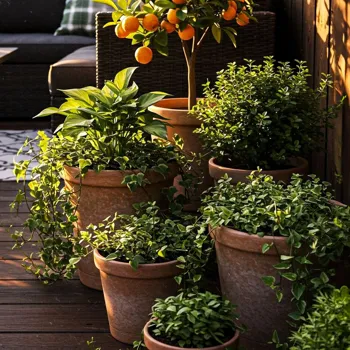
Terracotta pots are a classic choice, but they can be heavy and dry out quickly. Plastic pots are lightweight and retain moisture better, but they may not be as aesthetically pleasing. Wooden planters add a rustic touch to your terrace, but they require regular maintenance to prevent rotting.
The size of the container should be appropriate for the size of the plant. Small plants can be grown in small pots, but larger plants will need larger pots to accommodate their root systems. Ensure that all containers have drainage holes to prevent waterlogging.
Waterlogged soil can lead to root rot, which can be fatal to plants. Consider using pot feet or risers to elevate your containers off the ground. This will improve drainage and allow air to circulate around the pots. Group containers together to create a more cohesive look.
You can group plants with similar needs together to make watering and fertilizing easier.
Choosing the right compost and soil mix for healthy plant growth
Selecting the right compost is extremely important. Choosing the right soil mix is essential for providing your plants with the nutrients they need to thrive. Avoid using garden soil in containers as it can become compacted and poorly drained.
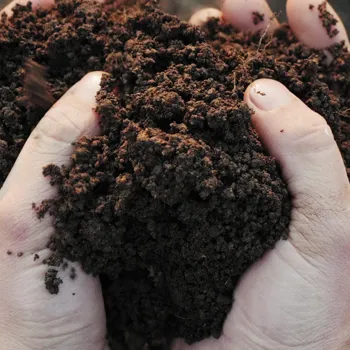
Instead, opt for a well-draining potting mix specifically designed for containers. A good potting mix should contain a blend of peat moss, perlite, and vermiculite. Peat moss helps retain moisture, perlite improves drainage, and vermiculite helps aerate the soil.
You can also add compost to your potting mix to provide your plants with additional nutrients. Compost is a natural soil amendment that is made from decomposed organic matter. It is rich in nutrients and helps improve soil structure. Consider using raised beds for growing vegetables and herbs.
Raised beds provide excellent drainage and allow you to customize the soil mix to suit the needs of your plants. You can build your own raised beds using wood, bricks, or concrete blocks.
Amending soil with organic matter, such as compost or well-rotted manure, is vital for improving water retention, aeration, and nutrient content. Before planting, incorporate these materials into the top layer of your terrace garden soil to create a fertile growing medium.
Be sure to check the pH levels in your soil and make alterations accordingly.
Watering techniques crucial for terrace garden care
Watering Techniques are important for terrace garden. Watering is perhaps the most important aspect of terrace garden maintenance. How often and how much you water your plants will depend on the type of plants, the climate, and the type of containers you are using.
As a general rule, water thoroughly when the top inch of soil feels dry to the touch. Avoid overwatering, as this can lead to root rot. Water early in the morning or late in the evening to minimize water loss due to evaporation.
Consider using a watering can with a rose head to gently water your plants without disturbing the soil. If you have a large terrace garden, you may want to consider using a drip irrigation system. Drip irrigation delivers water directly to the roots of plants, minimizing water waste.
Mulching can help conserve moisture in the soil. Apply a layer of mulch around your plants to reduce evaporation and suppress weeds. Organic mulches like wood chips, bark, and straw will also decompose over time and add nutrients to the soil. Different plants have different watering needs.
Research the specific watering requirements of your plants and adjust your watering schedule accordingly. Some plants prefer to be kept consistently moist, while others prefer to dry out between waterings.
Regular maintenance is crucial for a healthy terrace garden
Now coming to the last thing is to regularly maintain your garden. Regular maintenance is crucial for keeping your terrace garden healthy and thriving. Prune your plants regularly to remove dead or diseased growth and to encourage bushier growth.
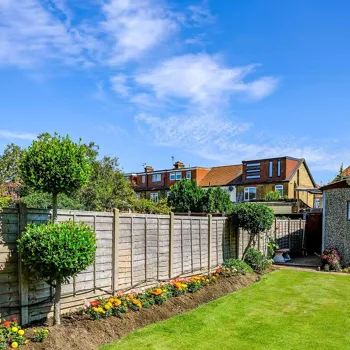
Fertilize your plants regularly to provide them with the nutrients they need. Use a balanced fertilizer that contains nitrogen, phosphorus, and potassium. Monitor your plants for pests and diseases. If you spot any problems, take action immediately to prevent them from spreading.
Handpick pests off your plants or use an organic insecticide or fungicide. Weed your garden regularly to prevent weeds from competing with your plants for resources. Remove weeds by hand or use a hoe. Add fresh compost to your soil regularly to replenish nutrients and improve soil structure.
Check the drainage holes in your containers regularly to ensure they are not blocked. Blocked drainage holes can lead to waterlogging and root rot. By following these essential tips, you can create a stunning urban terrace garden that will bring joy and beauty to your life.
So, what are you waiting for? Get started today and transform your terrace into a green oasis!
AI Generated Content. Glance/InMobi shall have no liability for the content